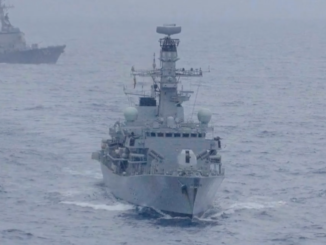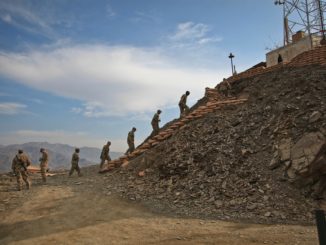 The present Pakistani government’s attempts to jockey the US for support have been met with constant affirmation of the Indo-US alliance. The US has clearly shown preference for a regionally stronger India and a weaker Pakistan.
The present Pakistani government’s attempts to jockey the US for support have been met with constant affirmation of the Indo-US alliance. The US has clearly shown preference for a regionally stronger India and a weaker Pakistan.
For example, the US’ top South Asian diplomat, Alice Wells, during her January Pakistan visit, raised the claim that CPEC included contracts to Chinese firms blacklisted by the World Bank. This came days after Pakistan’s Foreign Minister Shah Mahmood Qureshi asked for US support on FATF to spare Pakistan from being blacklisted for ‘terror financing’ and facilitate its exit from the greylist.
CPEC, the centerfold of Pakistan’s regional economic integration, was thus brought under the shadow of the FATF – another joint Indo-US means of pressuring Pakistan. For India, the prospect of the FATF extending its politicized scrutiny of Pakistan to include CPEC is a bright one, given India’s antipathy toward CPEC.
Pakistan, however, shows no signs of considering options to hedge its bets in response to this Indo-US dynamic. Maintaining an increasingly precarious dependency on the US support which never materializes, Pakistan’s US-centrism has led it to take what defence analyst Lt General (retd) Naeem Lodhi describes as a ‘plunge’, which rids it of opportunities for strengthening its regional posture.
Meanwhile, several opportunities for Pakistan to effectively compete with India for regional power are self-squandered and not so much as even discussed in the policy-making community as a caveat of its US-centric approach.
To expand discourse regarding Pakistan’s prospects on hedging its bets against the Indo-US alliance and countering Indian, the Indo-US regional bonhomie versus Pakistan and the squandered opportunities for Pakistan to counter it warrant closer inspection.
India, US and the Chabahar Corridor
Recently, Indo-Iran ties lost their main binding factor. US sanctions on Iran re-applied in November 2018 ensured that India greatly reduced Iranian oil imports – the main source for Iran’s state revenue. However, the US made an exception regarding Indo-Iran economic ties, which Pakistan paid little attention to: the sanctions-waiver for Chabahar Port’s operation by India and also a planned railway connection from Chabahar to Iran’s Afghanistan border by Indian contractors.
The corridor is tasked with receiving Indian goods via sea for land transport onward through Iran, Afghanistan and onward to Central Asia. However, in the context of the true nature of its importance to India, the USA’s waivers constitute the utmost significance for Pakistan’s strategists and policymakers.
The corridor is not purely economic, but geostrategically-oriented; sanctioned Iran and war-torn, state corruption-riddled Afghanistan are not ideal trade partners – and certainly not ideal venues for India’s foreign direct investment (FDI). Yet India invested massively there because the prize at hand is the encirclement of Pakistan. Afghanistan bears prime importance for this endeavour: India spent heavily in constructing and running dams, countrywide roads, power stations and more in Afghanistan.
Indeed, one might say that the Chabahar Corridor’s slated objective of tapping Central Asia’s market, while important due to the special allure of its energy and raw material to Indian manufacturing, is second-fiddle to India’s encircle-Pakistan objective. If connectivity with Central Asia was the foremost goal, why include dangerous Afghanistan in the corridor instead of an Iran-Turkmenistan route? The answer lies in the utility of Pakistan-bordering Afghanistan to India for supporting anti-Pakistan groups such as Baloch secessionists (BLA) and the Pakistani Taliban (TTP).

US regard for its Indian ally was enough to make it relent in its economic warfare against Iran, even if the major blow in the form of the hydrocarbons and shipping industry sanctions remained. Iran earns less through the India-operated Chabahar Port compared to hydrocarbon export earnings.
The US waiver for India, on the other hand, represented a win-win situation whereby India’s Chabahar Corridor and ‘encircle Pakistan’ project was resuscitated. Moreover, and also with key US interventions, India has managed despite its ever-expanding economic-military ties with the US – and its special relationship with Iran’s primary adversary across the Middle Eastern theatre of conflict Israel – to occasionally signal seriousness toward Chabahar to prevent Iran losing patience with its slow progress.
Indeed, India slashed Chabahar’s funding in July 2019 from 1.5 billion Indian Rupees to 450 million, showing Chabahar’s lack of momentum. However, timely assurance from the US in December 2019 to India of US help in securing investments from global banks to purchase $85 million worth of equipment for Chabahar Port allowed India to compensate for the aforementioned slashing of Chabahar’s funding in July. India followed by increasing Chabahar’s funding steeply and thus giving the slowed-down project the appearance of momentum for Iran’s ‘reassurance’.
The danger India averts here is, of course, Iran opting to join CPEC. However, this US-enabled Indian manoeuvring enabled to keep Iran from ‘abandoning’ Chabahar, by not renewing India’s December 2018 Chabahar lease once it expires or similar measures, contributes less to propping up the Chabahar Corridor than does Pakistan’s lack of initiative in recognizing the opportunity to comprehensively sway Iran to its side.
The Politics of CPEC
Pakistan can utilize a powerful option at its disposal towards this end in including Iran into CPEC, something Iran has expressed increasing interest in. The incentive in CPEC for Iran is arguably greater than it ever had vis-a-vis the Chabahar Corridor, i.e. a land link via Pakistan to China. Notably, Iran’s ambassador to India in September 2019 mentioned, while decrying Chabahar’s slow progress, Iran’s desire to build an LNG pipeline to China a running parallel to CPEC. China maintains noteworthy trade and defence ties with Iran despite US sanctions, continuing to import Iranian oil as well.
Additionally, the project bears an especially strategic dimension as it would save Iran the need to use its sanctioned tankers traversing highly militarized maritime trade routes in and beyond the Persian Gulf for its hydrocarbon exports to China. China, the world’s most energy-hungry market, would itself favour such a direct linkage with Iran parallel to CPEC.
More recently, in lectures from Iran’s Ambassador to Pakistan, Ali Hosseini, Iran’s CPEC interest was re-emphasized. Hosseini called for Pakistan’s Chinese-operated Arabian Sea port, Gwadar, to be connected to Chabahar and CPEC via Iran to thus connect to Central Asia and Europe for trade. In this context, he called for an alliance between Iran, China, Turkey, Pakistan and Russia as well. Given India’s zero-sum attitude toward CPEC, Hosseini’s statements are apparent as a signal of Iran’s willingness to leave India behind.
Moreover, further advantages accrue to Pakistan vis-a-vis countering India’s broader geo-economic plans for Eurasia through Iran joining CPEC if one accounts for the prospects for an expanded CPEC courtesy of Iran joining it.
These pertain to India’s North South Transport Corridor (NSTC). It is a Eurasian project starting in India, connecting to Iran’s Bandar Abbas Port, crossing Azerbaijan and terminating in Russia near Russia’s Baltic Sea coast proximate to Western Europe. It seeks to enhance India’s trade with Russia and Europe while the Chabahar Corridor taps into Central Asia.

With Iran connecting the more stable, efficient CPEC – backed by a trading power in China larger than that of India driving the NSTC – to Central Asia (via Turkmenistan as the rational choice, not Afghanistan) and Europe via Turkey, the NSTC would be out-done. These expanded axes of CPEC constitute shorter and thus more cost-effective trade-routes to Europe and Central Asia than India’s NSTC and Chabahar corridors.
With traders utilizing the expanded CPEC for accessing Europe and Central Asia benefiting off shorter-distance transit than Indian traders using the NSTC and Chabahar corridor, their appeal to the Eurasian market will be greater than that of the latter.
Most notably, India’s Chinese rival would be closer to the Eurasian market than Indian traders. India’s zero-sum opposition to and non-participation in BRI and CPEC would be rendered self-defeating by an Iran-connected CPEC, as Indian traders would not have the option to relocate industry to optimize proximity to Europe and Central Asia as would Indian rival China.
A CPEC connected to Europe (via Iran-Turkey) and Central Asia (via Iran-Turkmenistan) would specifically grant western Chinese provinces such as Xinjiang, whose economic growth China eagerly seeks, a special bonus in shortened distance to these two markets. The option of industry relocation from these provinces to Pakistan to further shorten their export distance to Eurasia would also subsequently yield greater gains through overall reduced costs, provided complimentary policies to oversee this from Pakistan and China.
India’s zero-sum rejection of CPEC and BRI will be rendered self-defeating as its traders will lack such a comparable boost, restricted to within India while their Chinese rivals profit more. Additionally, whatever India built as part of its anti-China NSTC and anti-Pakistan Chabahar Corridor in Iran would also suddenly become a pre-existing cog in the expanded CPEC, defeating India’s purpose again.
For Central Asia, the expanded CPEC serves as a closer direct-link to the substantially populous, nearby markets for its energy-and-raw-materials export-led economic growth as opposed to the tenuous and longer Chabahar Corridor to India’s vast market. This would entail a greater share of Central Asia’s coveted resources going to India’s rivals.
The export-led economic growth India invested in the NSTC and Chabahar Corridor to further boost would be hampered. With this, so would India’s capacity to maintain its prolific defence imports and give India second thoughts about brinkmanship with Pakistan.
The Utility of Iran Sanctions
The risk of secondary sanctions through connectivity with Iran would be incurred by Pakistan, but with China’s potential gains from Iran connecting to CPEC, Pakistan may possess a bargaining chip against getting sanctioned. Given the extensive ties of Western corporations to China, the US would face powerful domestic pressure to desist from sanctioning a China-backed transnational connectivity project that includes Iran.
The off-shore production of US corporate giants in China, whose top export customer is the US, being sanctioned-off from utilizing international financial systems for receiving their export earnings would spell disaster. Lower wages for their US employees, job lay-offs and worse could result as their revenue plummets.
This off-shore US industry, moreover, produces half of China’s exported goods and services and benefits heavily from CPEC’s trade distance-reduction and more efficient access to foreign markets. However, at this juncture closer consideration of the history of unilateral US sanctions and Iran’s specific case is required prior to asserting optimism on the durability of an Iran-connected CPEC vis-a-vis sanctions.
In the case of punishing Iran, such positive lobbying by Western businesses against sanctions on foreign states has been defeated before. Western oil and gas companies in the 1990s seeking to develop and market newly discovered Iranian fields pushed against sanctions on Iran, but could not rival the power of the Israeli interest seeking the sanctions.
The American Israeli Public Affairs Committee’s (AIPAC) pressure produced White House executive orders cancelling ongoing US contracts in Iran’s hydrocarbon industry while it drafted the Congressional Iran Libya Sanctions Act passed in 1996. The Act was extended in 2001, with AIPAC again out-doing lobbying by firms such as Exxon Mobil and has continued in adjust forms since then.
Thus, analysts may point out how connectivity with Iran may draw to Pakistan the ire of these sanctions-wielding interests powerful enough to override the interests of big businesses. However, Iran alone with its hydrocarbon and shipping industry being sanctioned and Iran in a China-led regional connectivity corridor being sanctioned are two different scenarios. The volume of international trade and commerce at stake whose movement requires interaction with these sanctioned Iranian industries would be far greater, making the extent of lost opportunities for international, West-based businesses greater if sanctions are imposed.
Additionally, US Treasury Secretary Steve Mnuchin last year blocked attempts by other federal departments to sanction China over its policies toward Muslims in Xinjiang, citing potential disruption by sanctions of trade tariff negotiations with China.
Considering Mnuchin’s usual appetite for sanctions to coerce states, notably versus Iran, Mnuchin’s stance on China showed cognizance of the fact that China being sanctioned would yield economic disaster for the US.
Furthermore, Israel’s high regard for China, who it leased its Haifa Port in 2018 and who constitutes both a growing market for Israeli tech companies and major source of investment in Israeli start-ups, may well see Israel and thus its powerful sanctions-obsessed lobbyists ‘accept’ the reality of CPEC. This would make China’s corporate friends promoting a soft stance on it easier.
Overall, utilizing Iran to expand CPEC bears less risk than pessimistic analysts may suggest. The reward of a region economically and strategically structured to Pakistan’s favour and not India’s remains an appealing one and worth considering.
Without Pakistan’s Regional Manoeuvring, India’s Designs Go Unchallenged
Ultimately, India continues furthering its geo-economic endeavours, knowing that Iran will not abandon them, despite their slowness. Pakistan neglects to commit to this countering of India’s West Asian hegemony designs to avoid upsetting states which hold India in higher regard than Pakistan, i.e. the US and GCC.
India can thus keep the NSTC, the Chabahar Corridor and with them Iran dangling by a thread rather than joining CPEC, while India itself accelerates economic and strategic ties with Iran’s enemies. This win-win equation for India is enabled by Pakistan’s inactivity.
How Pakistan’s US-Centric Orthodoxy Accepts Rather than Challenges India
The contours of Pakistan’s US-centrism find accurate description in a May 2018 analysis for Pakistan Politico by Moeed Yusuf, who in August 2019 became Prime Minister Imran Khan’s de facto national security advisor.
In it, Yusuf describes the global unipolar-to-multipolar transition but emphasizes that the US faces no challenge to its military preponderance of any comparison to the economic challenge it sees in China. In this context, Yusuf suggests a Pakistani policy of seeking to extract benefits from both the US and China while not committing to becoming part of any camp, be it pro-US or anti-US.
Yusuf then suggests that CPEC with its north-south axis be connected to an east-west corridor connecting Central Asia to India, citing Pakistan’s opposition to Indian trade via Pakistan with Afghanistan as the main reason India’s Chabahar corridor was developed. Yusuf posits that the subsequent importance of Pakistan as transit for Central Asian energy supplies going to India would make India rethink its hostility due to the enhanced importance to its energy security of a stable Pakistan.
The clearly dominant Hindu nationalist factor and its overriding of such mutually beneficial connectivity is ignored altogether. This is curious, given that at bare minimum, every analyst is aware of India’s zero-sum stance on CPEC based on Indian antipathy toward Pakistan (shrouded by India under ‘sovereignty concerns’ vis-a-vis Gilgit Baltistan).
Just as is the case with Pakistan’s current outreach to the US, the analysis shows cognizance of the Indo-US alliance. However, it also downplays it by not accounting for the continuous partisan US backing of India in periods of heightened tensions and concurrently prescribes greater US-Pakistan interconnectedness instead of Pakistan finally hedging its bets and ensuring it mitigates the brunt of the Indo-US alliance.
A strictly-economic rationality is afforded to India’s US-backed geo-economic endeavours by the suggestion that Pakistan embracing them – and the notion that zero-sum mentality India would oblige such an embrace – can bear ‘peace dividends’. The aspect of the Indo-US alliance seeking to subdue Pakistan is ignored despite its frequent practical manifestation.
With such an approach, Pakistan cannot so much as even contemplate the strategies discussed in the previous section to counter Indian designs which involve strengthening its capacity to launch various forms of aggression against Pakistan.
![]()




Be the first to comment